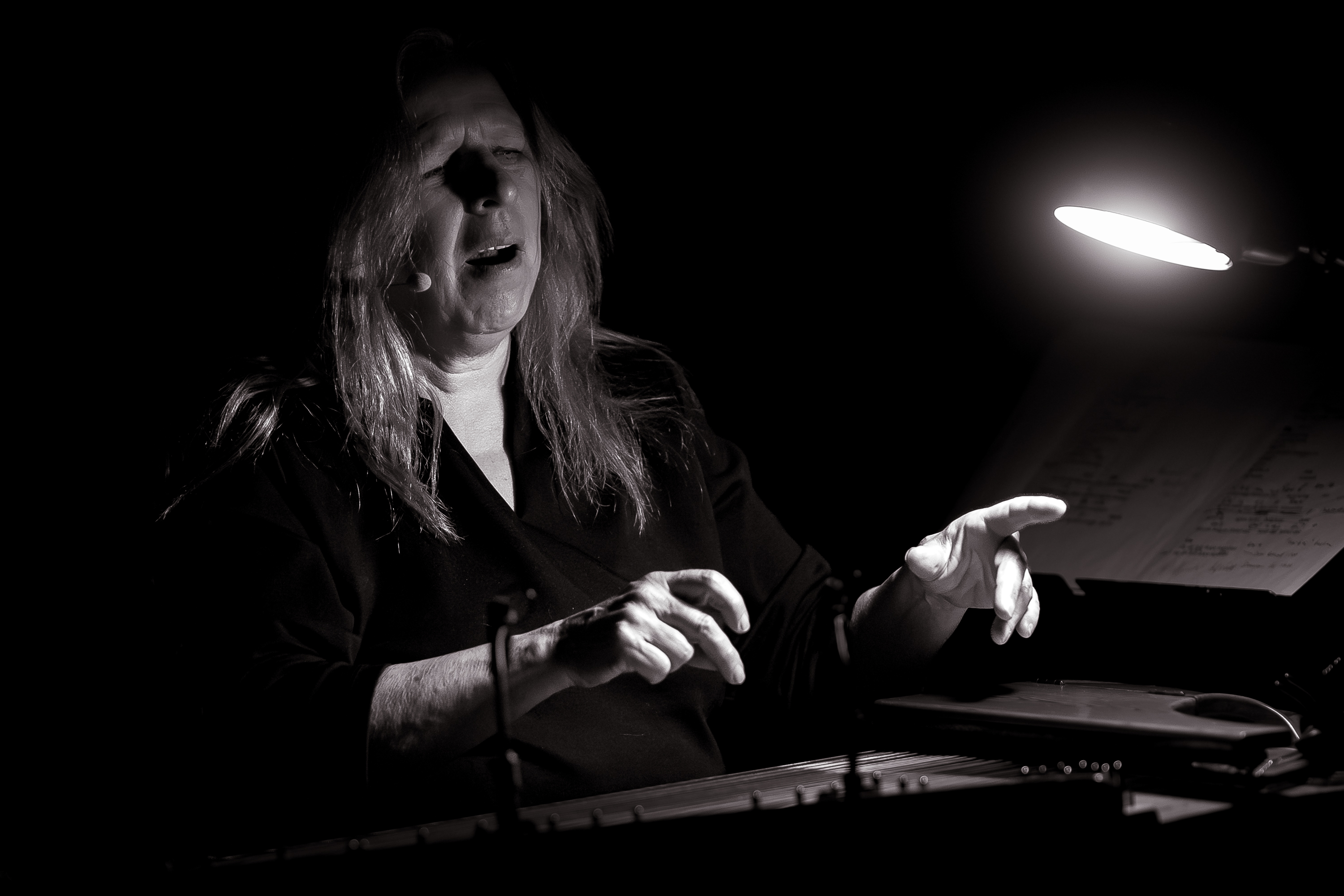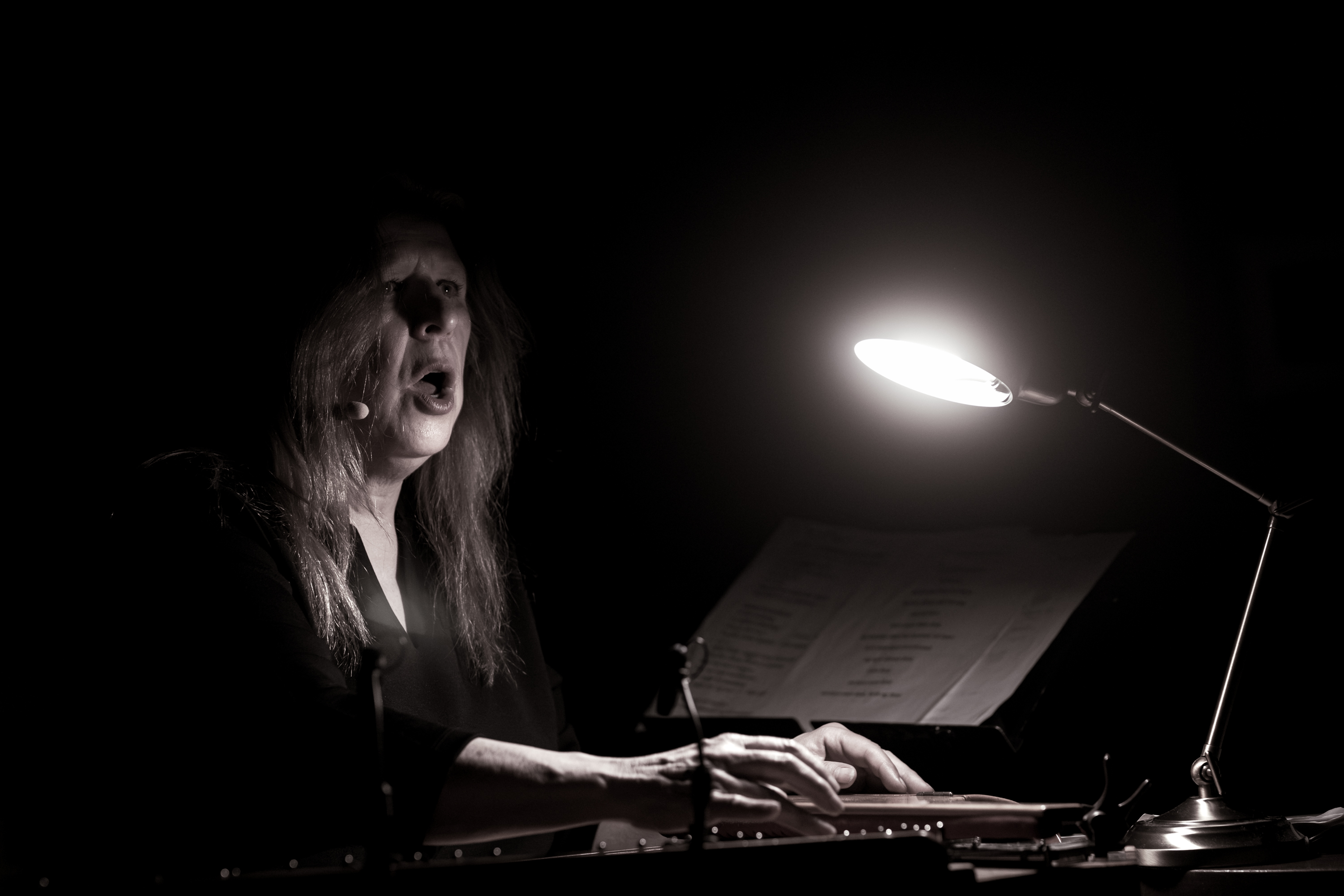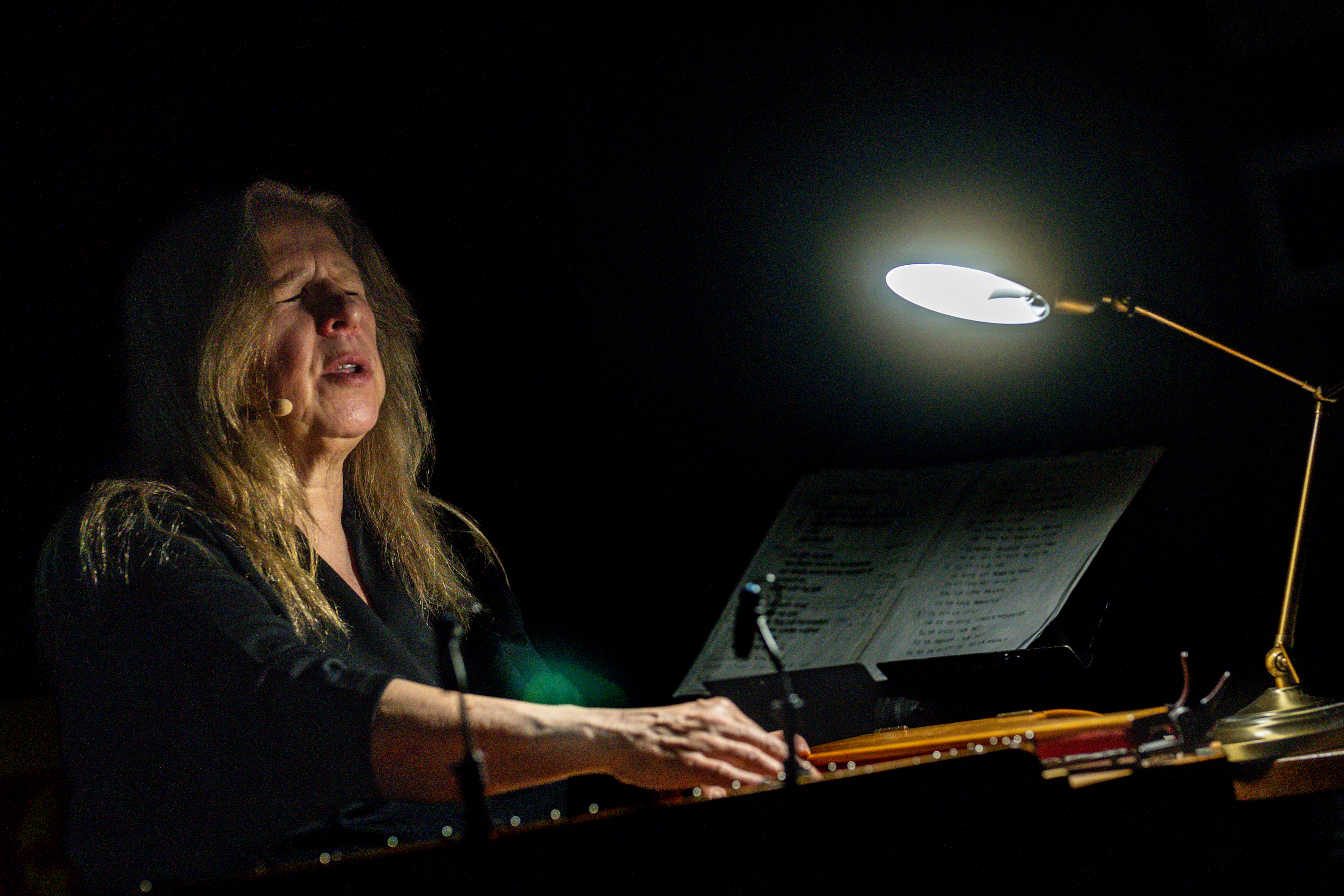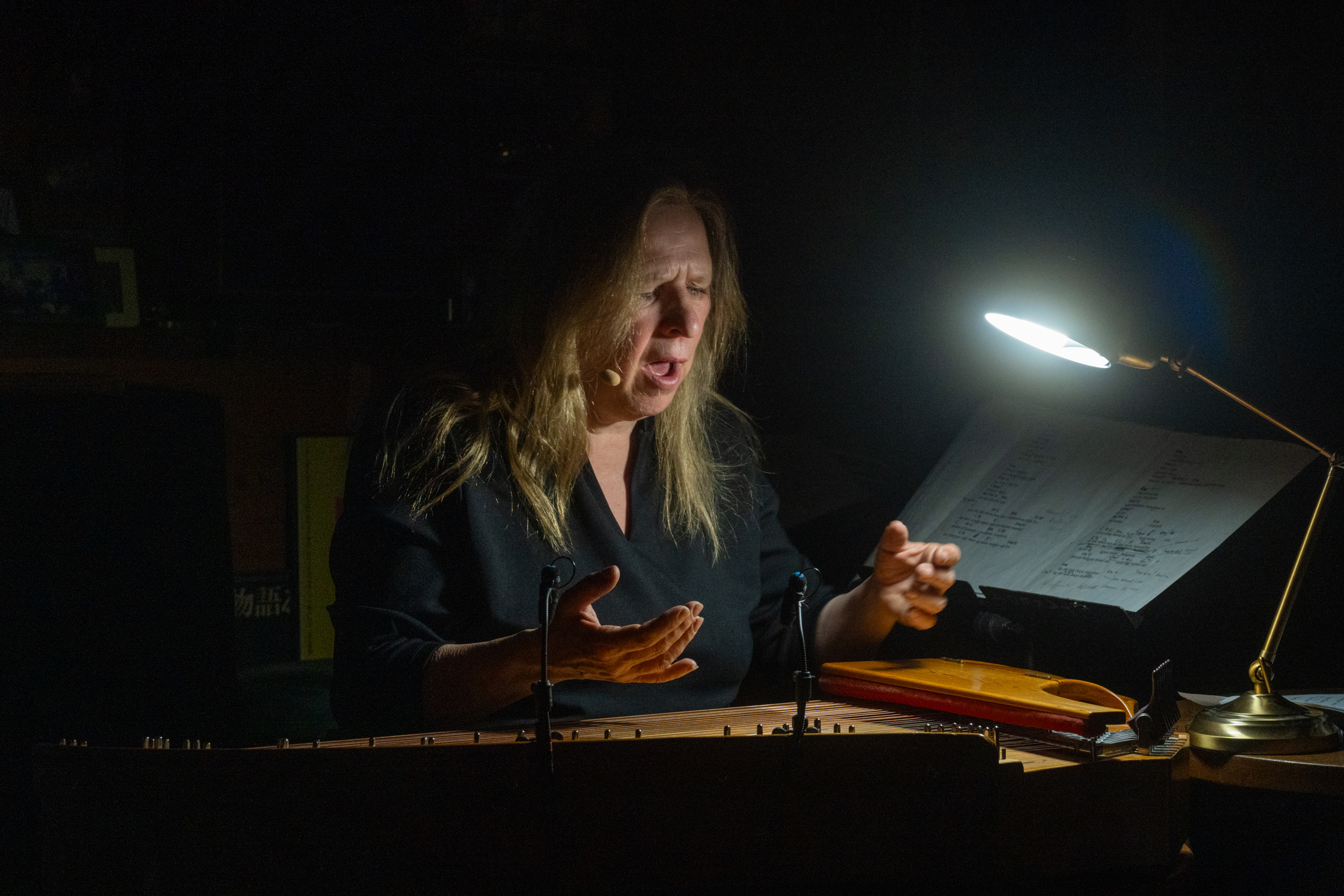Sinikka Langeland — Channeling the Spirits of the Forest at Mokkiriya, Kanazawa, 4/21/24
 Photo © by Christopher Pelham
Photo © by Christopher Pelham
Here I am at the historic Mokkiriya jazz cafe and live house, founded in 1971 in Kanazawa, Japan, with the unique Norwegian-Finnish musical artist Sinikka Langeland. Meeting her in western Japan is as fortuitous as it is unlikely. Sinikka performs jazz-inflected songs inspired by the traditional music of the Forest Finns on a 39-string kantele (a kind of harp that sits horizontally on a table) that are haunting and unforgettable. How did we get here?
This was the only night I could conceivably visit Kanazawa, and fatefully, Sinikka was performing at Mokkiriya on this night, on tour from Norway. Mostly, Japanese artists perform at Mokkiriya, but the other act I had managed to see at Mokkiriya, the year before, was a teenage American banjo prodigy whose singing also conveys a knowing way beyond her years. Why I needed to come to Japan to discover these two, I don’t know, but fate is always smiling on me.
Not knowing anything about Norwegian or Finnish traditional music, I watched a video of Sinikka. She sounded like nothing I’d ever heard before. Right away, I felt she was a healer, her voice and music arising from deep in the earth.
The first artist I thought that about was the gospel blues artist Blind Willie Johnson, whose recording “Dark Was the Night, Cold Was the Ground” was included on the Voyager Golden Record sent into space by NASA in 1977. His voice is gravelly and world-weary yet deeply connected to life. If a mountain or a canyon could sing, it might sound like him.
Sinikka’s singing is as clear as a bell. Yet, the purity of her voice and her decisive intonation, coupled with the dulcet sounds of her instrument, also express something profound, conveying compassion, mystery, and an ancient knowing. Gently, her music flows all around us, free of impurity and full of wonder, like a spring whose pristine and palliative waters well up from some primordial source.
Jazz Chicago describes her 2007 album “Starflowers,” her first for the prestigious German label ECM, as “a stunning merging of ancient folk melodies, observant introspection and inspired jazz into a recording that seems to exist almost timelessly outside the realm of music itself.”
The sound of her instrument is often shimmering, ethereal, meditative, and enchanting. Her vocals also seem to convey these qualities, as if her kantele and her voice are two vines of the same plant. And even though I cannot understand the words of her songs, I feel that her phrasing and expressiveness paint stories, by turns intimate and epic.
I wanted to know what makes Sinikka’s music so grounding, purifying, and ethereal — and what she was doing in Japan! It turns out she’d toured Japan with a band and played Mokkiriya nine years before. At that time, Mokkiriya’s owner, Mr. Hiraga, was worried about whether anyone would attend. While he does present foreign artists and various genres besides jazz, he thought Sinikka’s music might be too alien for his audience. However, an audience did appear, and they were all enchanted by the music’s lyricism, rich grooves, and air of sylvan freedom.
Now, she was back in Japan, performing as a solo artist to a full house, and she was kind enough to speak with me before the show. I wondered if she had been born into this tradition. No. Her mother was from a different area, Karelia, Finland, but when her parents married, they moved into the region that had been settled some six hundred years earlier by Forest Finns, an ethnic minority that lived close to nature in the forests.
Sinikka’s family, however, lived in a modern area, and she grew up studying piano and guitar and singing folk music. The music scene was quite vibrant, exposing her to many talented artists. At one point, she was curating a series.
Hungry to explore more, she went off to study at École Internationale de Théâtre Jacques Lecoq, immersing herself in the world of theater and literature. But at age 26, she changed directions and returned to Norway to intensively research the music of the Forest Finns.
Ecole Lecoq is a legendary physical theatre school that has trained numerous great artists such as Sasha Baron Cohen, Ariane Mnouchkine, Simon McBurney, and Julie Taymor, among many others. The school’s pedagogy draws on the tools of traditional storytelling practiced by generations of traveling theater companies dating back to the Middle Ages. I wondered what led her to study there only to return home to dive into the music of the Forest Finns. Having studied and worked with graduates of Ecole Lecoq many times myself, I wondered whether her music related to or was informed by what she learned at the school.
“I think so because Ecole Lecoq is like folk tradition theatre, old traditions, and because folk music is, of course, very connected to plays and to stories, so it’s something. Storytelling is very connected with the music.”
Sinikka’s mother introduced her to the kantele. Part of her wanted to continue studying theatre and literature in Paris, but music pulled at her heart more. She returned to Norway and earned a degree in musicology at the University of Oslo in 1992. From there, she became “absorbed in a massive research project to search through archives for old songs and music from Finnskogen.” This led her to release her first albums of medieval music, “Langt innpå skoga” in 1994 and “Har du lyttet til elvene om natta” in 1996, with the Grappa Musikkforlag label, for which she received some acclaim.
 Photo © by Christopher Pelham
Photo © by Christopher Pelham
In 1992, she settled in the Finnskogen town of Svullrya. The culture and domain of the Forest Finns suited her. Slowly, her vision of how to bring their world into her music took shape.
“I like this kind of philosophy that there is life in everything, I mean nature is everything, and yeah it’s so different from the other traditions in Norway, so that’s how I chose to go there instead of study theatre and more literature but then I understood that it’s music, music, music for me.”
The Forest Finns culture is animistic. They revere nature and believe all things are imbued with spirit. They try to live in close harmony with the forest, practicing sustainable agriculture, seeking guidance from the tree spirits about where to farm and how to treat illnesses, and asking permission before harming any tree. In this way, they avoid over-farming, support the natural and continual renewal of the forest, and live with a sense of gratitude and interconnectedness, serving the healthy circulation of energy rather than exploiting it.
Now, like the Forest Finns, Sinikka also lives in the forest, the better to avoid distractions and immerse herself in nature and music.
“I have quiet days, so I get all stuff out of my mind. I also have a place without television, without internet, just a little bit, a little internet on the phone, but for me it’s very important to get away all the things that are calling for you, to see what’s important for me to do, and to handle, to be bored, and maybe it comes just small, small things, and then afterwards you can build on that.”
Her music is largely drawn from what we know of the Forest Finns’ songs and runes, spells and ritual incantations. The runes I was familiar with were symbols carved into stones or wood. Rune singing (runolaulu) was apparently a fundamental part of the Forest Finns’ shamanic tradition though. How might one go about singing them? It seemed these runes were chants and included spells, prayers, and mythological stories. Often, the shamans would accompany the chanting on kantele, which they believed had mystical properties.
Sinikka’s 39-string kantele is a variation of their five-string kantele. Its sound was thought to evoke the serenity and mysticism of the forest. Reportedly invented by the mythological shaman Väinämöinen, the kantele was said to harmonize the natural and spiritual worlds and restore health to the listener’s mind and body. The kantele was often used in shamanic rituals to accompany listeners into trance states to receive spiritual visions.
So, Sinikka was playing a mystical instrument used by shaman to communicate with spirits, cast spells, and retell important cultural memories! No wonder she seemed like a healer. She was following in the footsteps of healers, listening to the forest, communing with the spirits.
“I really appreciate her sincerity, tolerance, and understanding that I don’t often meet with others. Sinikka is so comforting to speak with…about personal things as well. She is such a wise, rare, and good woman.” — saxophonist Trygve Seim, Portrait of ECM recording artist Sinikka Langeland | ECM Records video
But how did she become trained in this tradition? Have these practices really survived contact with modernity? Are the runes still in use? It seems that the Forest Finns no longer speak the Finnish language, having eventually adopted the local Norwegian, but some of the old rune songs have been preserved.
Sinikka says, “They were recorded in 1905 on wax, this old way of recording, but that was mostly like spells. They used it as a magic thing, but there have been some with melodies so I could hear some of these old Finnish people how they sounded, and I think that was incredibly important because it was the closest I could come to living tradition in a way. I also got help from listening to similar things in Finland.”
So, she found and listened to these old recordings. I asked her if she had learned how to play them on a 39-string kantele on her own.
“I had a few lessons in Finland, just to know how to, and, of course, I had some contact with other kantele players and seen what they’ve been doing.”
 Photo © by Christopher Pelham
Photo © by Christopher Pelham
As she continued to play and experiment with the 39-string kantele, she began to unlock more of its creative possibilities. Moreover, she began to feel a strong connection to it. Unlike the traditional 5-string kantele, her instrument can be tuned in all keys and features a five-octave range. Arranging traditional melodies on the 39-string kantele allowed for more variety and complexity of sounds and translated these songs into something new. After ten years of working at it, she released the book “Karhun Emuu” and the CDs “Tirun lirun” and “Runoja,” for which she was awarded the Edvard Prize.
“I haven’t done it for a long time, but I think I have drawn from my background in piano and guitar, and, of course, just trying to develop new techniques and find out what it can do. I also now use it as a free art expression. At first, you have to be very careful to try to do it exactly as historically as possible. Then, you can use it as a source for modern expressions. That’s how I think about it.”
Those early successes led to her signing by ECM, arguably the leading European label for acoustic jazz and folk music, and a string of successful albums that followed.
Now, she also composes and improvises upon the traditional tunes while continuing to elaborate on their themes. Her 2016 album The Magical Forest, for example, explicitly explores the mysteries of nature, the endless cycle of transformation, and the connection between the material and spiritual realms while expanding her sonic possibilities with the addition of vocal group Trio Mediæval. The result sounds both ancient and new, organic and otherworldly.
Lately, she’s also begun experimenting more lyrically, adapting contemporary poets such as 2023 Nobel Prize winner Jon Fosse, whose works evoke similar animistic or sylvan themes and tend to be minimalistic and open, lending themselves to musical treatment. The resulting Norwegian-language album Wind and Sun (2023) features his words set to organic arrangements performed by Sinikka and two standout jazz musicians, trumpeter Mathias Eick and saxophonist Trygve Seim, and garnered five-star reviews.
“When I compose, because I very often use the poems, I give space. In a way, I try to think that what’s in the poem can be improvised around, not just the music but also the poem. So I write it the way that there should be space for the musicians, if I have musicians with me, to improvise, and I also improvise a little bit myself in between.”
Traditionally, music-making was often a collective experience for the Forest Finns. As their intention was often to perform a blessing or healing or to seek spiritual guidance, the practice was necessarily improvisational and collaborative. When Sinikka is playing with other musicians, she takes the same approach, setting and following an intention while staying open to receiving new inspiration, which may lead them on unexpected flights of fancy.
“Sometimes we do the complete opposite of what we agreed on, and she is obviously having a lot of fun, going wherever it takes us.” — saxophonist Trygve Seim, Portrait of ECM recording artist Sinikka Langeland | ECM Records video
“She really demonstrates the versatility of the kantele, alternately using it to create the rhythm, set the melody and the sound, often at the same time.” — Martin Bjørnersen, music columnist, Portrait of ECM recording artist Sinikka Langeland | ECM Records video
In addition to the new music incorporating the poems of Fosse, Sinikka had several other new projects in the works. Showing no signs of slowing down, she seems to be enjoying a prolonged golden era.
“There is a composer who has composed a piece for kantele that is so difficult that I almost cannot do it, but his name is Magnar Åm, and we’re going to perform this summer. It’s the first time I order a piece, and I told him, you mustn’t make it too difficult, but he just makes his music, and then he adjusts it. So we work together to find a way of doing it.”
“And I also work with two Hardange fiddle players. You know the Hardange fiddle? That’s a Norwegian fiddle with under strings. One player is Erlend Apneset. He’s very good at both traditional Hardange fiddle music and improvising, and the other one is also a fantastic older Hardange fiddle player, and I compose for a new project, so yeah, I really try to have time to make new music, because it’s important.”
You can find Sinikka’s music in all the usual outlets and learn more about her here:
 Photo © by Christopher Pelham
Photo © by Christopher Pelham
0コメント